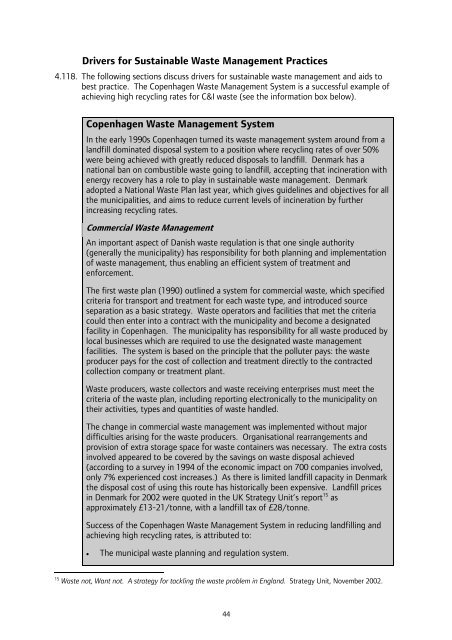London Wider Waste Strategy - London - Greater London Authority
London Wider Waste Strategy - London - Greater London Authority
London Wider Waste Strategy - London - Greater London Authority
You also want an ePaper? Increase the reach of your titles
YUMPU automatically turns print PDFs into web optimized ePapers that Google loves.
Drivers for Sustainable <strong>Waste</strong> Management Practices<br />
4.118. The following sections discuss drivers for sustainable waste management and aids to<br />
best practice. The Copenhagen <strong>Waste</strong> Management System is a successful example of<br />
achieving high recycling rates for C&I waste (see the information box below).<br />
Copenhagen <strong>Waste</strong> Management System<br />
In the early 1990s Copenhagen turned its waste management system around from a<br />
landfill dominated disposal system to a position where recycling rates of over 50%<br />
were being achieved with greatly reduced disposals to landfill. Denmark has a<br />
national ban on combustible waste going to landfill, accepting that incineration with<br />
energy recovery has a role to play in sustainable waste management. Denmark<br />
adopted a National <strong>Waste</strong> Plan last year, which gives guidelines and objectives for all<br />
the municipalities, and aims to reduce current levels of incineration by further<br />
increasing recycling rates.<br />
Commercial <strong>Waste</strong> Management<br />
An important aspect of Danish waste regulation is that one single authority<br />
(generally the municipality) has responsibility for both planning and implementation<br />
of waste management, thus enabling an efficient system of treatment and<br />
enforcement.<br />
The first waste plan (1990) outlined a system for commercial waste, which specified<br />
criteria for transport and treatment for each waste type, and introduced source<br />
separation as a basic strategy. <strong>Waste</strong> operators and facilities that met the criteria<br />
could then enter into a contract with the municipality and become a designated<br />
facility in Copenhagen. The municipality has responsibility for all waste produced by<br />
local businesses which are required to use the designated waste management<br />
facilities. The system is based on the principle that the polluter pays: the waste<br />
producer pays for the cost of collection and treatment directly to the contracted<br />
collection company or treatment plant.<br />
<strong>Waste</strong> producers, waste collectors and waste receiving enterprises must meet the<br />
criteria of the waste plan, including reporting electronically to the municipality on<br />
their activities, types and quantities of waste handled.<br />
The change in commercial waste management was implemented without major<br />
difficulties arising for the waste producers. Organisational rearrangements and<br />
provision of extra storage space for waste containers was necessary. The extra costs<br />
involved appeared to be covered by the savings on waste disposal achieved<br />
(according to a survey in 1994 of the economic impact on 700 companies involved,<br />
only 7% experienced cost increases.) As there is limited landfill capacity in Denmark<br />
the disposal cost of using this route has historically been expensive. Landfill prices<br />
in Denmark for 2002 were quoted in the UK <strong>Strategy</strong> Unit’s report 15 as<br />
approximately £13-21/tonne, with a landfill tax of £28/tonne.<br />
Success of the Copenhagen <strong>Waste</strong> Management System in reducing landfilling and<br />
achieving high recycling rates, is attributed to:<br />
• The municipal waste planning and regulation system.<br />
15 <strong>Waste</strong> not, Want not. A strategy for tackling the waste problem in England. <strong>Strategy</strong> Unit, November 2002.<br />
44
















